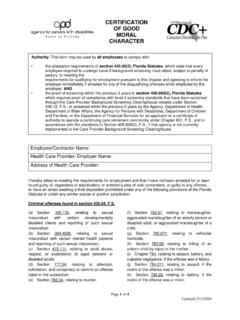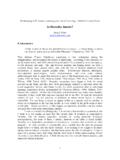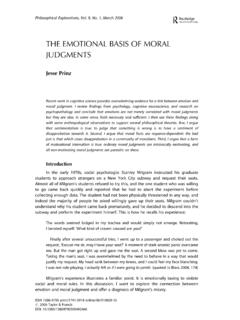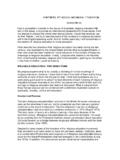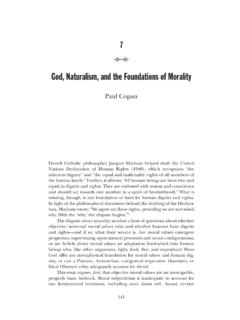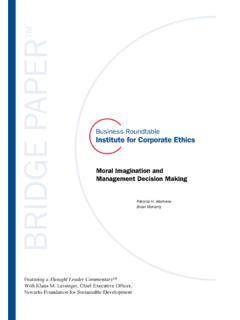Transcription of Catholic Moral Decision Making - Holy Spirit Parish …
1 Handout on Moral Decision Making Catholic Moral Decision Making Some Catholics of the past had one word to describe the Church, and that word was institution. When the Church set out to define itself at the Second Vatican Council, that all changed. The Church Fathers determined that institution is an extremely narrow vision of Church. The Church in its fullness is so much more than an institution. The Church Fathers provided images and metaphors to describe the essence of Church and to keep us from being boxed in to one narrow way of thinking. Such images and metaphors required the use of our imagination. Yet in spite of the effectiveness of such metaphors and images, they are not without limits. While a metaphor comes close to the reality, it never quite is the reality. Metaphors simply help us unlock the layers of mystery contained within that which the metaphor attempts to describe. Theologians have created certain metaphors that help us explain the many dimensions of morality and our response to it.
2 Many people think that morality is nothing more than a set of rules, regulations, and the necessary requirement to obey them. Morality is so much more than that. Theologians have explored various models to help us understand the way in which our understanding of morality has developed and how we have developed in relation to morality. Models of Morality The Rational / Philosophical Model A Moral Principle is a fundamental or comprehensive assumption of the law. It is: Universally valid Unchanging in content Holds absolute claim on our submission Is self-evident and does not require justification. Examples: do good / avoid evil Always treat others as ends, never as means . A Moral Norm Ensures that our external actions are in harmony with our internal lives Provides a rational and public Moral foundation in a pluralistic and fragmented world Are more specific than principles by stating the content of our individual actions. What is Natural Law?
3 Thomas Aquinas on law External Law God's plan Divine Law norms we would not know without divine revelation Natural Law our participation in the eternal law o Often misunderstood as an attempt to understand the laws of nature. o It is concerned with discovering the natural and supernatural ends for which we were created, which we define as happiness Human Law precepts based on natural law, but which are human creation Natural Law Provides norms which evolve from reflection on the natural law. Involves the totality of human experience Contemporary approach to Natural Law Real Moral good determined by the community's experience Experiential result of our collective experience Sources: Catholic Faith, Life, & Creed Moral Decision Making McBrien, Richard P., Catholicism, (Harper San Francisco, 1994). Handout on Moral Decision Making Consequential the consequences of actions contribute to the formulation of Moral norms Historical the human person changes and develops in life stages and history Proportional the morally right choice will achieve the greatest measure of good over evil Limits to Natural Law o No room for courage, spirituality o Ignores our life's goal, desirability of happiness and the role of suffering o Leaves questions of justice unanswered o Life becomes a series of tasks, directed by what I should do.
4 Legal model. The first metaphor or model is the legal model. This is the oldest model and flows from society's need to organize itself. Rules help maintain peace and harmony within the society. Rules are to be followed. If they are not followed, there are consequences and punishment. This legal model was and is so ingrained in people's consciousness that morality became synonymous with the law. Everything was, and for the most part is today, understood by many within the context of the legal system. Within that legal context, therefore, God is the lawgiver and human beings are obliged to obey. o Within this legal system there exist divine law and natural law. o There are rewards and punishments in the here and the hereafter. o The believer must obey. o Extreme disobedience results in expulsion from the Church. Some limitations to the legal model Scrupulosity and circumvention. When an institution creates a large body of laws, there is always the presence of two extremes in response to those laws.
5 One extreme is scrupulosity and flows from a fear of not perfectly following the law. The other extreme seeks to circumvent the law. Such persons ask how much they can get away with before they commit a sin. The legal system, while nevertheless necessary, also gives rise to other extreme responses. When an institution imposes rigid observance of the law (much like the Pharisees of the New Testament, who required that faithful Jews follow over 600 specific laws, many of them extremely burdensome to poor peasants) the response is often a rebellious questioning of the authority behind the law. The law then is perceived as oppressive and burdensome. Relativism. However, today we are faced with a different extreme response. Some people have relativized the legal nature of the law. For them the law is not the heart of morality; they do not believe that morality should be legislated. The sentiment for them becomes: No one should tell me what I should or should not do.
6 If I am an adult and it feels right to me, then I am the one who determines if it is right for me or not. Some see this posture as liberating in that it provides the adult with the freedom to act responsibly and with personal conviction. A truly mature adult, however, comes to understand that while law is not the central component in morality, it is a necessary component of it, a necessary balance to freedom. In spite of some obvious limitations to the legal model of morality, it is important to note that society will always need agreed-upon norms and values that uphold the common good and those norms must and do drive our values. Sources: Catholic Faith, Life, & Creed Moral Decision Making McBrien, Richard P., Catholicism, (Harper San Francisco, 1994). Handout on Moral Decision Making Other models of morality The Love Model Another model of morality is rooted in love. The gospel mandate to love one another, the two great commandments, is the heart of the Beatitudes, the new law Jesus handed down at his Sermon on the Mount.
7 Such love is directed toward others. Love-based morality insists that the love Jesus taught us by word and example should drive our Moral responses to all life situations. However, this model has its limitations. It is not always easy to determine what the most loving action is in a given situation. WWJD (What would Jesus do?) does not always work. Or worse, we use our own criteria of morality and put it squarely on Jesus' shoulders in order to give divine acceptance to our own narrow (often anti-gospel) way of thinking. For example, a televangelist once used WWJD to defend his support of the death penalty. He failed to consider the reality that Jesus promoted a gospel of non-violence and that he himself was an innocent victim of the death penalty! When confronted with the love model's limitations, we always revert back to the legal model that we know and that works so well. It is not that the love model is not full of the best intentions; it simply fails us when it comes to determining the right thing to do in many life circumstances.
8 The Discipleship Model The discipleship model of morality is based on an intimate, reciprocal relationship with Jesus Christ. Commissioned followers of Christ follow the example of the New Testament and join with other Christians in community to establish the reign of God in their midst. Such a model is a welcomed change from the rigidity of the legal model. Much discernment happens within the context of community as it seeks to live out the gospel in day-to-day life situations. However, just as the love model falls short, there are no clear directives given to address the complex situations that Christians face. What is lacking are concrete answers to what is morally right or wrong. While love and discipleship are good foundations for living the Moral life, more is needed. The Inner Conviction Model or Moral Conscience Model In this model we joyfully accept personal responsibility for living according to accepted Moral norms. When Moses gave the Ten Commandments to the people of Israel, we often think that they were given this difficult code by which to order their lives, when in truth the people of Israel understood the Ten Commandments to be their joyful reciprocal response to the love, care, and nurturing shown to them by God, a God with whom they shared a covenant relationship.
9 In this inner conviction or Moral conscience model, directives of the law guide us, but we choose to make a personal mature commitment to live by the Law's imperative. The law is not imposed; it is embraced. The law is embraced in response to our love relationship with the God who is in covenant relationship with us. In this model the law drives our values and becomes the basis of our Moral Decision Making , our Moral conscience. Sources: Catholic Faith, Life, & Creed Moral Decision Making McBrien, Richard P., Catholicism, (Harper San Francisco, 1994). Handout on Moral Decision Making In this model we do not follow the law out of fear or blind obedience. We follow the law out of a mature commitment to live an authentic life of integrity, a life informed by Moral norms that are freely embraced and lived. In this model people act in complete freedom of choice the freedom to say, Yes to God. Conscience is not simply the tool within us to determine if we should do the right thing and avoid the immoral or wrong thing.
10 Conscience drives our entire approach to life. It helps us discover God's divine design for our lives; it helps us discover who we are, how we are to live, and God's ultimate will for our lives. Conscience is developed (or not) from childhood as we learn to obey the rules and norms of society. It grows and develops as we learn that such norms are for the good of all people and that a well-ordered society is in the best interest of everyone. I follow all the traffic laws not just because it is the law, but because I care about the welfare of other citizens. Conscience achieves its highest level when we act not because of some obligation to follow the law, but because it is the right and Moral thing to do. We develop a good conscience over time by creating the habit of good behavior. When we habitually tell the truth, we become known not just as a truthful person, but we learn to discern truthfulness and the lack of it in specific life situations.

